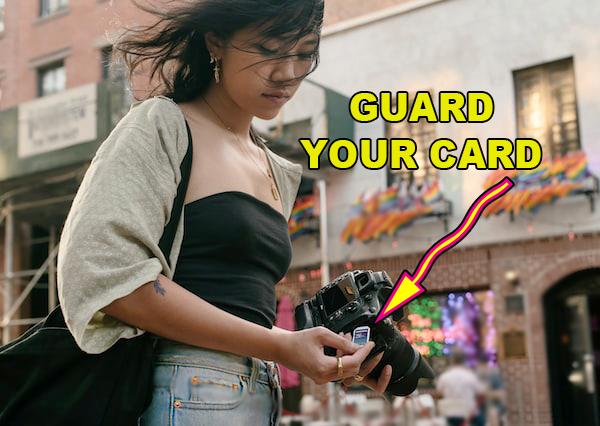Warning! NEVER Loan or Sell Memory Cards!

Deleted images do not “go away.” Formatting a memory card does not “erase” the images. Never sell or loan a memory card unless you’re willing to risk the potential of sharing every image, video and other file that’s ever been saved to it. The same applies to hard drives, SSDs and other recording media. Here’s why it happens, and how to protect yourself.

Scary? Your bet it is. But you can prevent it from happening
When an image is deleted from a memory card or other storage media, the space that the image file physically occupied as digital data is marked “available” and new image data can be written to that space. Formatting a memory card does little more than mark ALL of the space available. In other words, image files do not fully disappear unless they are overwritten by other files or deliberately “scrubbed” or “wiped” by special software. The Format command tells the firmware in the card that it’s okay to write new files over the ones that already exist. It does not vanish the existing files.
This is not a bug or oversight; it’s a safety precaution. If this were not the case, you’d lose accidentally deleted files forever. It also makes the Formatting process much faster.
 Recover Images
Recover Images
Inexpensive software from SanDisk and others can recover deleted images, video files and other documents in full or in part, and this is great in the event of unintentional deletion. But the software that rescues us has a dark side. This has two important implications for all, especially in this world of common person-to-person online auction transactions.
First, the consequences of accidental deletions and inadvertent formatting can very likely be reversed, although it’s not 100% certain. If you delete or format unintentionally, stop shooting immediately. If you continue shooting, the new images may overwrite the ones you want to restore. There is no 100% guarantee that the data can be resurrected, but the odds are in your favor to recover at least part of it. Download SanDisk RescuePro or another brand of Undelete Software and follow the onscreen directions. RescuePro has saved my bacon more than once, I’m unhappy to admit. This is why I recommend it over all others, but probably there are other brands equally as effective.
The recovery process can take a long time—plan on it. The file names change, and the images may be restored whole or partially. The fragmented frames are caused by the way data is written to the card on noncontiguous spaces.
The second implication is potentially worse. With the right software and a little patience, others might be able to view the images you thought you deleted from your memory card. Even though the images are completely innocent, do you really want to give them to strangers?

Wipe Cards Clean
SanDisk RescuePro software has a built-in option to wipe cards 100% clean by completely filling them with randomly sequenced 1s and 0s. The only other way to render a card neutered and inert (short of tossing it into the fireplace) is to format it and then shoot pictures of the sky, ground or your feet until the card is full. With a large capacity card, this could take weeks. Seriously.
If you are dealing with an Intel SSD (Solid State Drive) you can wipe it clean using the Intel SSD Memory and Storage (Intel MAS) Tool. Keep this in mind if you ever decide to sell your PC.

While there is no guarantee that any data can be recovered from a blundered-up card, the chances are strong enough that you should protect yourself with these extra steps before loaning or selling a card. Or make it your policy to never share your media.
Don’t make the mistake of unwitting confidence that I once did by not keeping some brand of Undelete Software installed at all times. Some brands of memory cards come with a free full or trial subscription. Don’t wait until you need it. Buy Undelete Software today and practice with it now so you are prepared to deal with accidents without panic.
—Jon Sienkiewicz








































